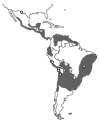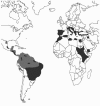Studies on protozoa in ancient remains--a review
- PMID: 23440107
- PMCID: PMC3974329
- DOI: 10.1590/s0074-02762013000100001
Studies on protozoa in ancient remains--a review
Abstract
Paleoparasitological research has made important contributions to the understanding of parasite evolution and ecology. Although parasitic protozoa exhibit a worldwide distribution, recovering these organisms from an archaeological context is still exceptional and relies on the availability and distribution of evidence, the ecology of infectious diseases and adequate detection techniques. Here, we present a review of the findings related to protozoa in ancient remains, with an emphasis on their geographical distribution in the past and the methodologies used for their retrieval. The development of more sensitive detection methods has increased the number of identified parasitic species, promising interesting insights from research in the future.
Figures




Similar articles
-
Parasitic diversity found in coprolites of camelids during the Holocene.Parasitol Res. 2015 Jul;114(7):2459-64. doi: 10.1007/s00436-015-4442-y. Epub 2015 Apr 11. Parasitol Res. 2015. PMID: 25859925
-
Retrieving ascarid and taeniid eggs from the biological remains of a Neolithic dog from the late 9th millennium BC in Western Iran.Mem Inst Oswaldo Cruz. 2017 Sep;112(9):593-595. doi: 10.1590/0074-02760160420. Mem Inst Oswaldo Cruz. 2017. PMID: 28902284 Free PMC article.
-
Paleoparasitological results for rodent coprolites from Santa Cruz Province, Argentina.Mem Inst Oswaldo Cruz. 2010 Feb;105(1):33-40. doi: 10.1590/s0074-02762010000100004. Mem Inst Oswaldo Cruz. 2010. PMID: 20209326
-
History of human parasitology.Clin Microbiol Rev. 2002 Oct;15(4):595-612. doi: 10.1128/CMR.15.4.595-612.2002. Clin Microbiol Rev. 2002. PMID: 12364371 Free PMC article. Review.
-
Old parasites for a new world: the future of paleoparasitological research. a review.J Parasitol. 2009 Apr;95(2):365-71. doi: 10.1645/GE-1676.1. J Parasitol. 2009. PMID: 18702568 Review.
Cited by
-
Exploring the environmental diversity of kinetoplastid flagellates in the high-throughput DNA sequencing era.Mem Inst Oswaldo Cruz. 2015 Dec;110(8):956-65. doi: 10.1590/0074-02760150253. Epub 2015 Nov 24. Mem Inst Oswaldo Cruz. 2015. PMID: 26602872 Free PMC article. Review.
-
Genetic diversity and population structure of Leishmania (Viannia) braziliensis in the Peruvian jungle.PLoS Negl Trop Dis. 2022 May 23;16(5):e0010374. doi: 10.1371/journal.pntd.0010374. eCollection 2022 May. PLoS Negl Trop Dis. 2022. PMID: 35605021 Free PMC article.
-
The evolutionary history of Plasmodium vivax as inferred from mitochondrial genomes: parasite genetic diversity in the Americas.Mol Biol Evol. 2013 Sep;30(9):2050-64. doi: 10.1093/molbev/mst104. Epub 2013 Jun 2. Mol Biol Evol. 2013. PMID: 23733143 Free PMC article.
-
The history of leishmaniasis.Parasit Vectors. 2017 Feb 15;10(1):82. doi: 10.1186/s13071-017-2028-5. Parasit Vectors. 2017. PMID: 28202044 Free PMC article. Review.
-
Genomic palaeoparasitology traced the occurrence of Taenia asiatica in ancient Iran (Sassanid Empire, 2th cent. CE-6th cent. CE).Sci Rep. 2022 Jul 14;12(1):12045. doi: 10.1038/s41598-022-10690-2. Sci Rep. 2022. PMID: 35835776 Free PMC article.
References
-
- Abbott A. Earliest malaria DNA found in Roman baby graveyard. Nature. 2001;412:847–847. - PubMed
-
- Allison MJ, Bergman T, Gerszten E. Further studies on parasites in antiquity. Am J Clin Pathol. 1999;112:605–609. - PubMed
-
- Altamirano-Enciso AJ. Comprometiendo la estructura osteo-facial de las poblaciones humanas del antiguo Perú por la leishmaniasis tegumentaria de forma mucosa, PhD Thesis . ENSP/Fiocruz; Rio de Janeiro: 2000. 213 pp
-
- Altamirano-Enciso AJ, Marzochi MCA, Moreira JS, Schubach AO, Marzochi KBF. Sobre a origem e dispersão das leishmanioses cutânea e mucosa com base em fontes históricas pré e pós-colombianas. Hist Cienc Saude Manguinhos. 10:853–882. - PubMed
-
- Araújo A, Jansen AM, Reinhard K, Ferreira LF. Paleoparasitology of Chagas disease -A Review. Mem Inst Oswaldo Cruz. 2009;104(Suppl. I):9–16. - PubMed
Publication types
MeSH terms
LinkOut - more resources
Full Text Sources
Other Literature Sources
Medical
Miscellaneous

